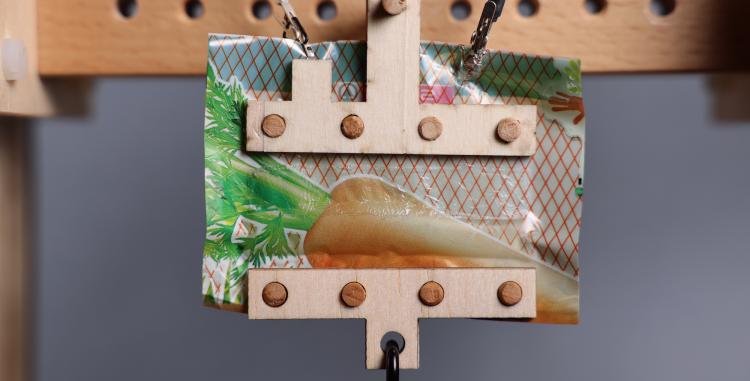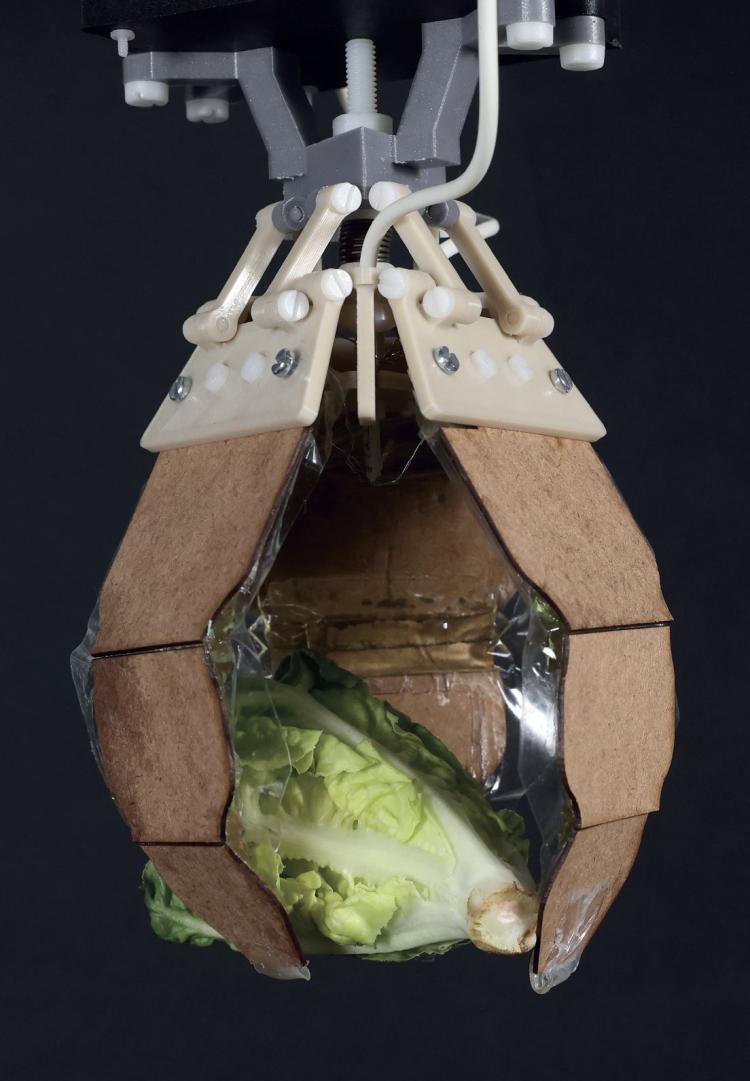Grad student helps design ‘artificial muscles’ you can toss in the compost bin

An "artificial muscle" made, in part, from material designed for biodegradable grocery bags. (Credit: Max Planck Institute for Intelligent Systems)
Say “hello” to the robots of the future: They’re soft and flexible enough to bounce off walls or squeeze into tight spaces. And when you’re done with them, you can toss these machines into a compost bin to decompose.
That’s the vision of a team of engineers, including CU Boulder graduate student Ellen Rumley. In a paper published last month in the journal Science Advances, the researchers described their designs for a new kind of robotic actuators, or “artificial muscles.” The group’s actuators, which work by shifting fluid around in squishy sacs, can power robotic arms and legs with life-like movements. They also dissolve naturally in soil over a period of a few months, making them much more sustainable than previous models.
[video:https://youtu.be/qoqePU0qRC8]
“You could dispose of them in an industrial compost bin,” said Rumley, co-first author of the new study and researcher in the Paul M. Rady Department of Mechanical Engineering at CU Boulder. “We hope the project will inspire other engineers to develop robotics with sustainability in mind.”
Think Baymax, the pillowy robot from the film Big Hero 6, mixed with a biodegradable grocery bag.
The project emerged from a long-running effort led by Christoph Keplinger, formerly an assistant professor of mechanical engineering at CU Boulder and now director at the Max Planck Institute for Intelligent Systems in Stuttgart, Germany. In 2018, he and his colleagues debuted a line of artificial muscles they call Hydraulically Amplified Self-Healing ELectrostatic (HASEL) actuators. Like human muscles, these actuators can bend robotic arms like a bicep or squeeze claws and grippers.
But what they couldn’t do, until now, was disappear in a landfill.
In the new study, the team developed a series of soft robotic actuators entirely made of sustainable ingredients. The muscles are about as versatile as traditional HASEL actuators and, in some cases, can flex for 100,000 cycles or more without breaking.
“It was particularly exciting that we ended up with a materials system that is fully biodegradable and can still match key performance metrics of actuators made from non-biodegradable materials,” said Keplinger, co-founder of Artimus Robotics, a Boulder-based company that develops and sells HASEL actuators.
“The sustainability of the new materials system now opens up very interesting avenues for applications that require components designed for single- or short-term use, for example, in the area of food handling or medical applications.”

Time lapse images of biodegradable HASEL actuators decomposing over 50 days. (Credit: MPI-IS)
Artificial muscles for robots
Rumley’s own search for a different kind of robot goes back years. As a high school student in Anchorage, Alaska, Rumley belonged to a robotics club where she learned to design robots for FIRST Tech Challenge competitions. She could never get over the inelegance of hard robots made from metal and plastic.
“I had felt like the rigidity of the robots was a big limiting factor of their physical capabilities,” said Rumley, who started her graduate studies in Boulder before moving to Germany in 2020 to work as a visiting researcher in Keplinger’s lab. “That was especially jarring when you saw a person walking next to a robot.”

A prototype robotic gripper made from entirely sustainable componets. (Credit: MPI-IS)
Soft robots, however, could potentially solve those issues by combining advances in engineering with the squishiness and flexibility of biological organisms.
HASEL actuators are made up of transformer oil inside plastic pouches, which are partially covered by a thin layer of an electrical conductor. If you apply electricity across the conductors, the pouch will “zip together,” Rumley said, squeezing the fluid from one end to the other. As a result, the pouches change shape and can apply force to devices like a robotic limb.
Keplinger helped found Artimus Robotics to commercialize the actuators in 2018 alongside Tim Morrissey, Eric Acome, Shane Mitchell and Nick Kellaris with support from Venture Partners at CU Boulder. Kellaris, who earned his doctorate from CU Boulder in materials science and engineering in 2020, was also a co-author of the new paper.
In the new study, Rumley and her colleagues set out to identify sustainable components that could replace every bit of those early designs.
“We were in search of the perfect combination of compatible materials that would make for a high-performance biodegradable muscle,” she said.
As part of a systematic and extensive materials science effort, Rumley and her colleagues tested various biodegradable candidates for replacing the plastic pouches in their actuators. One good option, a biodegradable polyester blend, is commonly used in shopping bags and even came stamped with images of carrots.
The team’s final designs for artificial muscles can lift nearly as well as ordinary HASEL actuators and will degrade in a composting facility in about 6 months.
Robots of the future
Rumley, a 2020 recipient of the U.S. National Science Foundation’s Graduate Research Fellowship, will earn her doctorate degree from CU Boulder but will spend the rest of her time as a student in Europe. There, she’s learned to speak a little German and enjoys international life, though she sometimes pines for the wide-open landscapes of Colorado and Alaska.
“I miss wading into a river and catching a salmon,” she said. “This isn’t big in Germany.”
But the engineer says it’s worth it to be part of a team of researchers helping to usher in a new era of robotics. Keplinger, for example, has imagined that HASEL actuators could one day power Iron Man-like “exosuits” that could help people who are paralyzed to walk.
“The applications are really exciting, especially for devices that can assist folks who are physically impaired,” Rumley said. “I am motivated to develop technology capable of empowering underserved populations.”


